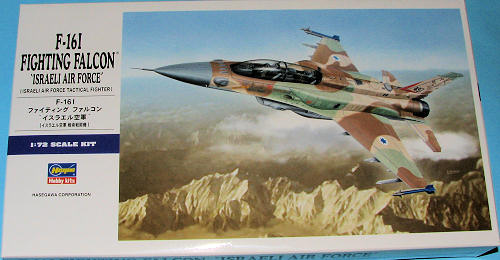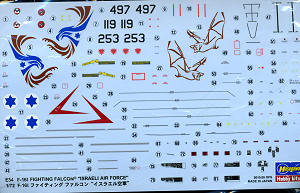
Hasegawa 1/72 F-16I Fighting Falcon® "Israeli Air Force"
| KIT #: | 01564 |
| PRICE: | $34.35 at www.greatmodels.com (42.00 SRP) |
| DECALS: | Three options |
| REVIEWER: | Scott Van Aken |
| NOTES: | Upgraded standard kit |

| HISTORY |
The F-16I is a two-seat variant of the Block 52 developed for the Israeli Defense Force – Air Force (IDF/AF). Israel issued a requirement in September 1997 and selected the F-16 in preference to the F-15I in July 1999. An initial "Peace Marble V" contract was signed on 14 January 2000 with a follow on contract signed on 19 December 2001 for a total procurement of 102 aircraft. The F-16I, which is called Sufa (Storm) by the IDF/AF, first flew on 23 December 2003, and deliveries to the IDF/AF began on 19 February 2004. The F-16I has an estimated unit cost of approximately US$70 million (2006).
The F-16I's most notable difference from the standard Block 52 is that approximately 50% of the American avionics have been replaced by Israeli-developed avionics (such as the Israeli Aerial Towed Decoy replacing the ALE-50). The addition of Israeli-built autonomous aerial combat maneuvering instrumentation systems enables the training exercises to be conducted without dependence on ground instrumentation systems, and the helmet-mounted sight is also standard equipment. The helmet-mounted sight, head-up display (HUD), mission computer, presentation computer, and digital map display are made by Elbit Systems of Israel. Furthermore, the F-16I is able to employ Rafael's new Python 5 imaging infrared-guided high-agility air-to-air missile. The F-16I also has the Israel Aircraft Industries (IAI)-built removable conformal fuel tanks (CFT) added to extend its range; removal takes two hours. Key American-sourced systems include the F100-PW-229 turbofan engine, which offers commonality with the IDF/AF's F-15Is, and the APG-68(V)9 radar.
| THE KIT |
 If you have ever built a 1/72 Hasegawa F-16 kit, then you will recognize most of the sprues. They are quite unchanged since the kit was first released and while there is a bit of flash, the molding is in remarkably good shape. You do get new sprues for this version that include the conformal fuel tanks, new fin/rudder section, strike camera pod, AMRAAM missiles and a bunch of small lumps and bumps. Basically everything from sprue Q on up is new or pretty new and has parts for this variant.
If you have ever built a 1/72 Hasegawa F-16 kit, then you will recognize most of the sprues. They are quite unchanged since the kit was first released and while there is a bit of flash, the molding is in remarkably good shape. You do get new sprues for this version that include the conformal fuel tanks, new fin/rudder section, strike camera pod, AMRAAM missiles and a bunch of small lumps and bumps. Basically everything from sprue Q on up is new or pretty new and has parts for this variant.
Naturally, you'll have to do some carving on the original molds to remove some small items that are no longer used. Hasegawa has been thoughtful enough to modif y the inside of several parts (like the fuselage) to incorporate new parts location holes. The instructions will show you which ones are germane to this particular variant. As you can see from the parts layout diagram, there will be quite a few bits not used on this kit.
y the inside of several parts (like the fuselage) to incorporate new parts location holes. The instructions will show you which ones are germane to this particular variant. As you can see from the parts layout diagram, there will be quite a few bits not used on this kit.
Markings are provided for three aircraft, all in the same camouflage scheme used by the IAF on their Sufas. It covers the two of the four units that fly this aircraft. Two of them are from 'The Negev' squadron, while one is from 'The Bats' and is the one shown on the cover. The decals are well done and come with all sorts of stencils. Those wanting to do other units will need to look to Isradecals for those options. Colors are, of course, from the Gunze catalogue.
| CONCLUSIONS |
How far the Hasegawa F-16 kit has come. I have to admit that at $42.00 SRP, it is rather pricey considering that the base kit used to be less than $10 when it first came out. However, Hasegawa kits are frequently discounted to make the purchase more palatable and this one is a pretty cool looking aircraft.
| REFERENCES |
http://en.wikipedia.org/wiki/F-16I#F-16I_Sufa
October 2011
I got this one at www.greatmodels.com where there are tons of kits and accessories.
If you would like your product reviewed fairly and fairly quickly, please contact the editor or see other details in the